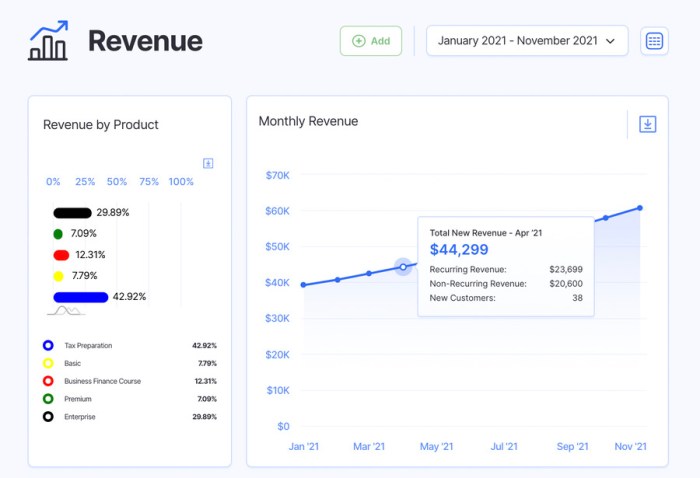Get ready to dive into the world of financial metrics for startups, where numbers tell a story of success and growth. This guide will walk you through the essential metrics and key performance indicators that can make or break a startup’s journey to the top.
Whether you’re a budding entrepreneur or a seasoned business owner, understanding these financial metrics is vital for steering your startup in the right direction.
Importance of Financial Metrics for Startups
Financial metrics are essential for startups as they provide valuable insights into the financial health and performance of the business. By tracking key financial metrics, startups can better understand their revenue, expenses, profitability, and overall financial stability. This information is crucial for making informed decisions, setting goals, and identifying areas for improvement.
Examples of Key Financial Metrics
- Revenue Growth Rate: This metric measures the percentage increase in revenue over a specific period, indicating the company’s ability to generate more income.
- Burn Rate: The burn rate shows how quickly a startup is spending its available capital, helping to determine the runway before running out of funds.
- Gross Margin: Calculated as (Revenue – Cost of Goods Sold) / Revenue, the gross margin indicates the profitability of each product or service sold.
- Customer Acquisition Cost (CAC): CAC measures how much it costs to acquire a new customer, helping startups evaluate the effectiveness of their marketing and sales strategies.
- Churn Rate: Churn rate reflects the percentage of customers who stop using a product or service over a specific period, highlighting customer retention and satisfaction levels.
Monitoring Financial Metrics for Informed Decisions
By regularly monitoring financial metrics, startups can gain a deeper understanding of their business operations and performance. This data-driven approach allows entrepreneurs to identify trends, evaluate the success of different strategies, and make data-backed decisions to drive growth and sustainability.
Types of Financial Metrics

Financial metrics are essential for startups to track and analyze their performance. There are two main types of financial metrics: leading and lagging.
Leading vs. Lagging Financial Metrics
Leading financial metrics are indicators that can help predict future performance. These metrics are proactive in nature and can provide insights into the potential success or challenges a startup may face. On the other hand, lagging financial metrics are historical in nature and provide a backward-looking view of a startup’s performance.
Common Financial Metrics for Startups
- Revenue Growth Rate: This metric measures the increase in revenue over a specific period, indicating the startup’s ability to generate more income.
- Customer Acquisition Cost (CAC): CAC helps startups understand how much it costs to acquire a new customer, influencing marketing and sales strategies.
- Runway: Runway measures how long a startup can operate with its current cash reserves before needing additional funding.
- Gross Margin: Gross margin calculates the profitability of a startup’s core business operations, essential for sustainable growth.
Significance of Using a Combination of Financial Metrics
Using a combination of financial metrics provides a comprehensive analysis of a startup’s financial health. Each metric offers a unique perspective on different aspects of the business, allowing entrepreneurs to identify strengths, weaknesses, and areas for improvement. By analyzing multiple metrics together, startups can make informed decisions, set realistic goals, and track progress effectively.
Key Performance Indicators (KPIs) for Startups
When it comes to measuring the success and growth of a startup, Key Performance Indicators (KPIs) play a crucial role. KPIs are specific metrics that are used to evaluate the performance of a business and indicate progress towards achieving its goals. Unlike other financial metrics that provide a general overview of a company’s financial health, KPIs are more focused and targeted, giving a clear picture of the areas that are critical for success.
Examples of Relevant KPIs for Startups
Setting and tracking the right KPIs can help startups stay on track and make informed decisions to drive growth. Some examples of KPIs that are particularly relevant for startups include:
- Customer Acquisition Cost (CAC): This metric helps startups understand how much it costs to acquire a new customer. Keeping this cost low is crucial for sustainable growth.
- Monthly Recurring Revenue (MRR): MRR helps startups track the predictable revenue generated from subscriptions or recurring services, providing a clear indication of financial health.
- Churn Rate: Churn rate measures the percentage of customers who stop using a product or service over a specific period. Keeping this rate low is essential for maintaining customer loyalty and revenue.
- Revenue Run Rate: This metric extrapolates current revenue over a certain period, providing insight into future revenue projections and helping startups plan ahead.
Driving Growth and Success Through KPIs
Setting and tracking KPIs can drive growth and success for startups by providing a clear roadmap for achieving goals and making data-driven decisions. By focusing on key metrics that directly impact the business, startups can identify areas of improvement, allocate resources effectively, and measure progress towards success. KPIs not only help startups stay accountable but also enable them to pivot quickly, adapt to market changes, and optimize performance for long-term sustainability.
Financial Ratio Analysis for Startups
Financial ratio analysis is a crucial tool for startups to evaluate their financial health and performance. By examining various financial ratios, startups can gain valuable insights into their operations, profitability, liquidity, and overall financial stability.
Key Financial Ratios for Startups
- 1. Profitability Ratios: These ratios measure a startup’s ability to generate profits relative to its revenue, assets, or equity. Examples include:
- Gross Profit Margin: (Gross Profit / Revenue) x 100%
- Net Profit Margin: (Net Profit / Revenue) x 100%
- 2. Liquidity Ratios: These ratios assess a startup’s ability to meet its short-term financial obligations. Examples include:
- Current Ratio: Current Assets / Current Liabilities
- Quick Ratio: (Current Assets – Inventory) / Current Liabilities
- 3. Debt Ratios: These ratios indicate the level of debt a startup has and its ability to repay debt. Examples include:
- Debt-to-Equity Ratio: Total Debt / Total Equity
- Interest Coverage Ratio: Earnings Before Interest and Taxes (EBIT) / Interest Expense
Interpreting Financial Ratios
Financial ratios provide valuable insights into a startup’s financial performance. By analyzing these ratios, startups can identify their strengths and weaknesses, make informed decisions, and take corrective actions to improve their financial health. For example, a low liquidity ratio may indicate a potential cash flow issue, while a high debt ratio may signal excessive financial leverage. Overall, understanding and interpreting financial ratios can help startups make strategic financial decisions and achieve long-term success.






